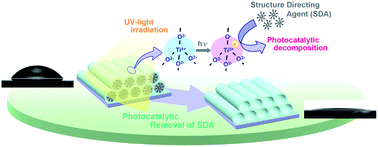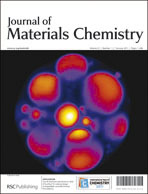This article describes a novel preparation method for highly hydrophilic porous thin films via photocatalytic removal of a structure-directing agent (SDA) under UV-light irradiation at ambient temperature. Since this technique requires no calcination process, it can effectively coat surfaces that have low thermal resistance, such as polymer substrates. In the present study, Ti-containing mesoporous silica thin films (Ti-MSTF) were prepared on polycarbonate and quartz substrates using a newly developed method involving UV-light irradiation. The film surface wettabilities were investigated by water contact angle measurements. Complete removal of the SDA was confirmed by time-dependent changes in the FT-IR spectra under UV-light irradiation, which also suggested that Ti-oxide moieties in the mesoporous silica framework play a crucial role in the removal of the SDA. XRD, UV-vis and XAFS measurements revealed that the Ti-MSTF had a mesoporous structure and isolated Ti-oxide moieties. The water contact angle measurements indicated that the Ti-MSTF exhibited highly hydrophilic property after photocatalytic removal of the SDA, and maintained this property under dark conditions for several days.

You have access to this article
 Please wait while we load your content...
Something went wrong. Try again?
Please wait while we load your content...
Something went wrong. Try again?


 Please wait while we load your content...
Please wait while we load your content...